In August 2021, the departure of the last evacuation flight from the Bagram Airfield marked the chaotic end of an era of American occupation in Afghanistan. The end of the war in Afghanistan has brought back discussions on the role of the Bush Doctrine in the US’s Global War on Terrorism.
The US troops left the country in the hands of the Taliban, from whom they were ‘liberated’ back in 2001 under ‘Operation Enduring Freedom’. The intervention was in response to the al-Queda’s 9/11 attack on World Trade Center and Pentagon. On the very next day, then President George W Bush came up with a grand strategy devised to wipe out the terrorist organization that put a grave threat to its national security.

Image courtesy-Reuters
The proactive counter-terrorism policies pursued by the United States were guided by the neoconservative aspirations of its political leadership. Often deemed as Bush Doctrine, these policies directed the American invasion of Afghanistan and elsewhere.
Bush Doctrine
As the name suggests, the doctrine postulated under the Presidency of George W Bush was not entirely a brainchild of his administration. The core ideas advanced in Bush doctrine essentially came from the neo-conservative discontent in the 1990s. The neoconservatives were critical of President Bill Clinton’s treatment of the Iraqi regime after the Persian Gulf War. They wanted to unseat Saddam Hussein to prevent further emanation of threats from the region against American interests. President Clinton did not pursue this. He ended the war when Kuwait was freed from Iraqi occupation.
However, by the late 1990s, proposals were made to transform Clinton’s foreign and defence policies from liberal multilateral internationalism to unilateral militarism to defend its interest overseas. Strategists Paul Wolfowitz, Donald Rumsfeld, and Dick Cheney were leading advocates of this proposal. Nonetheless, a popular dissent against this approach compelled the government to let the design aside and continue with the prevailing policies.
When Bush took office in 2001, he appointed Cheney, Rumsfeld, and Wolfowitz to key positions in his administration. He and his fellow Republicans actualized the neoconservative dream of ‘America first nationalism’.
After the September 11 World Trade Centre attack, Bush espoused a grand strategy to secure national security and American interests globally. In general, the Bush doctrine refers to a series of policies the United States pursued in its War on Terror which became the rationale for its invasion of Afghanistan and later Iraq. Key tenets of the Bush doctrine can be outlined as a pre-emptive strike, unilateral militarism, fighting overseas, and the spread of democracy.
For the United States, it is not only a tool to fight against terrorism but also to subvert regimes, wherever it wants, to further its political and economic interests. These tenets guided the American military campaign in Afghanistan for two decades. Let us look at each tenet.
Tenets of the Bush Doctrine
1. Unilateralism
The first tenet is unilateralism. It allows Washington to single-handedly take and implement decisions without regard to the interest of other actors, whether it is allies or foes. President Bush was quite sceptical of the multilateral approach since the beginning of his presidency. Often cited as a revelation of this tendency is his refusal to join the International Criminal Court and Kyoto Protocol.
Unilateral militarism refers to the engagement in military operations elsewhere to protect national security without waiting for the approval or consent of the parties involved. The War on Terror and the occupation of Afghanistan were handy manifestations of this policy. This approach effectively rules out the fear of counter-reactions that normally restrict state behaviour. Unilateralism, when adopted as part of foreign policy, lets the President adopt bold and realpolitik strategies in his international commitments.
2. Preemptive Strike
The second tenet of the Bush Doctrine is the concept of preemptive strike. It is the military action against a terrorist organization or a rogue state to mitigate a presumed threat against the United States. Most often, a preemptive strike falls outside the pretext of international law and causes a breach of the United Nations resolutions. With the help of intelligence, the United States planned and executed operations to destroy any adversaries.
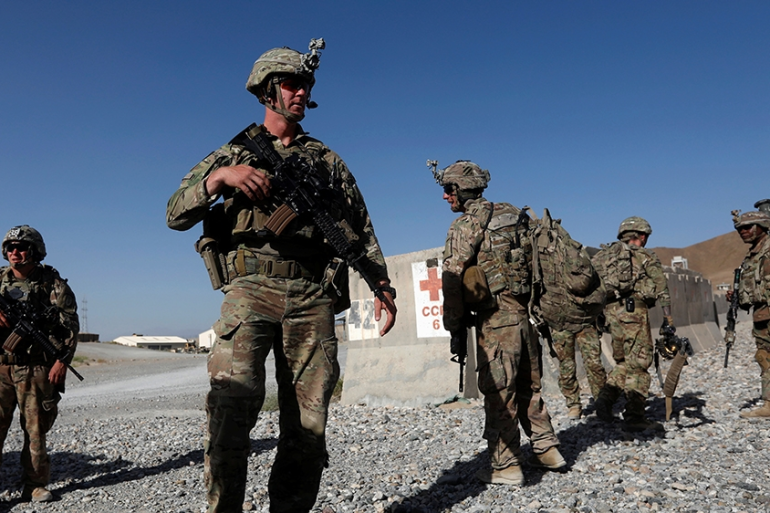
3. Attacking Countries That Harbour Terrorists
The third tenet is that the United States will not differentiate between the terrorist who commits the act of violence and those countries which harbour terror. It thus announced the willingness to fight overseas since nations that are safe havens for extremism is equally belligerent like an aggressor. The doctrine has also delineated between friendly and hostile regimes. Those who are not with Washington are regarded as an enemy in its War of Terror.
4. Promotion of Democracy
The fourth and last tenet is the promotion of democracy. To accomplish preemption and unilateralism, American supremacy should be established beyond any doubt. Reinforcing American military hegemony became necessary to put into work a foreign policy doctrine based on unilateral pre-emptive action. Exporting democracy to the rogue states was the definitive solution to every identifiable threat. The liberals believe that terrorism originates from authoritarian countries that undergo social disarray for a sustained period.
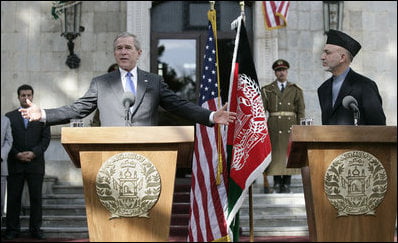
Image courtesy-The White House
By transforming the regime in rouge states into democratic governments, the United States can protect itself from threats emanating from such countries. It also asserts the liberal notion of democratic peace theory.
Why Did the Bush Doctrine Fail?
For centuries several powers have tried to occupy Afghanistan; the British, the Soviets, and now the Americans. However, only a few have succeeded in their endeavour to control and administer the country. The United States is just the latest addition to the long list of tried and failed. Initially, the Bush doctrine helped the US to invade Afghanistan. Its unilateral campaign could overthrow the weak Taliban regime and dismember the al-Qaeda camps in the territory. Nothing is astonishing about that because the US was in an advantageous position in terms of military capabilities.
Nevertheless, the period afterwards was tragic not just for the hegemonic power or the puppet government it installed but for the Afghan people.
Though America’s hegemonic militarism was partly successful in annihilating the network of al-Qaeda from Afghanistan, preemption and regime change strategies failed miserably. Let us examine how Bush Doctrine let the US military campaign fail in Afghanistan.
Crisis of Preemption
The pre-emptive strike strategy intends to abort all possible sources of terror way before it induces any act of harm. Here the focus is on the physical extermination of all facilities and networks that sustain terrorist organizations, whether they are state-sponsored or not. It can be achieved with the use of superior military technology and intelligence. Yet, the US failed to counter the resurgence of the Taliban in Afghanistan and the Islamic State in its neighbourhood. It points to the inability of armed missions to deal with the ideological foundations of terrorism.
War is not only fought with guns and tanks but with ideologies.
American militarism failed to demolish the narratives and ideologies set by these terror groups, which vilify any external efforts to democratize Afghan society. Strong political messages embedded in the narratives influence the public’s general attitude toward occupiers. Bush doctrine’s blind faith in forceful destruction undermined the ideological war between the West and the Islamic world.
Another aspect of the Afghan society that the violence could not completely erode is tribal networks. The Taliban and Islamic State exploit the tribal connections to strengthen their grip in regions far from Kabul. Similarly, the United States intervention could not restrain the growth of al-Qaeda networks from forming Islamic State in Iraq and Syria. All these cases reveal the limitations of militarism and preemption in fighting terror.
Democracy or Stability
National security and territorial integrity are crucial for modern states. Any attempt of breach will invite reactionary measures. On this ground, initially, the US intervention in Afghanistan was somewhat justified. The immediate goal there was to ruin the network of Al-Qaeda and to punish those countries that nurture terror. However, as time passed, these short-term goals were replaced by long-term ones to prevent the growth of any terrorist groups within the Afghan territory.
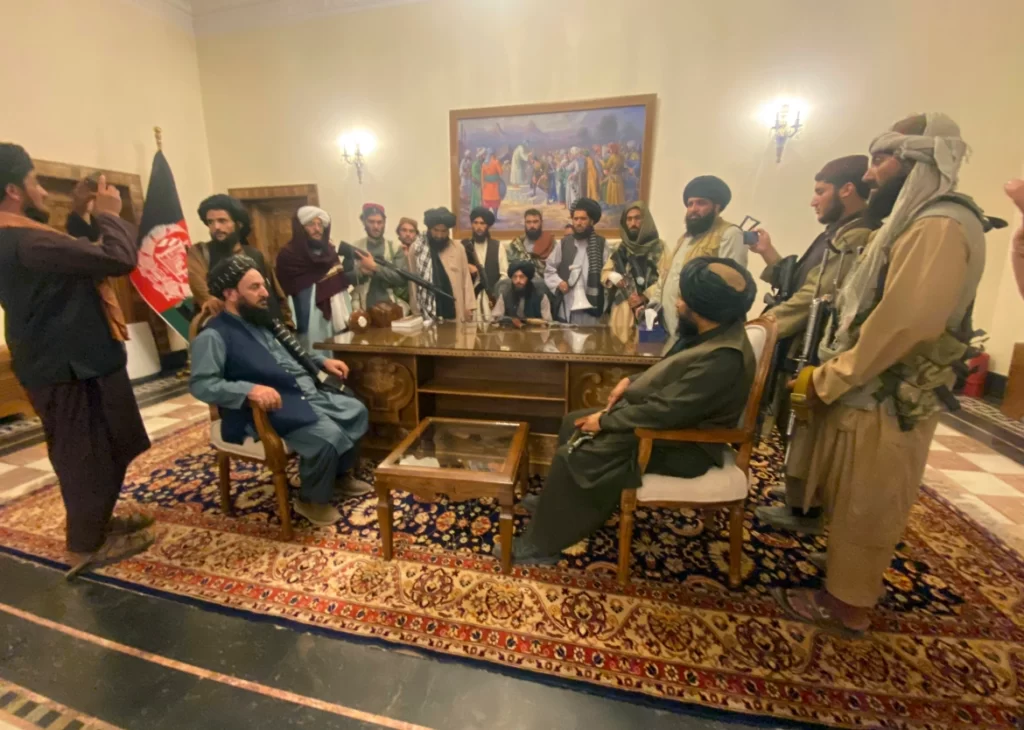
Image courtesy-Al Jazeera
While the immediate objective was achievable by military might, the long-term objective needed much more than guns and missiles. So the US resorted to democratization as a measure to bring peace to the country. It began attempts to promote democracy and helped to set up self-government as a means to vindicate their occupation morally. Based on the western model, they installed a puppet government that acted in tune with American interests. Unsurprisingly, it thwarted the natural evolution of political processes within the country. People became sceptical of their political leadership and lost faith in democracy.
The US idea of exporting democracy to Afghan soil and restoring peace in the region backfired. The US-backed government became corrupt. People who wanted to find a way out of this peril were hopeless. After twenty years of occupation, the bush doctrine could not create any coherent political structure with popular legitimacy in the country. For people who have gone through a tumultuous period of multiple foreign occupations, the US’s western model of the national building was an ill-fitted suit.
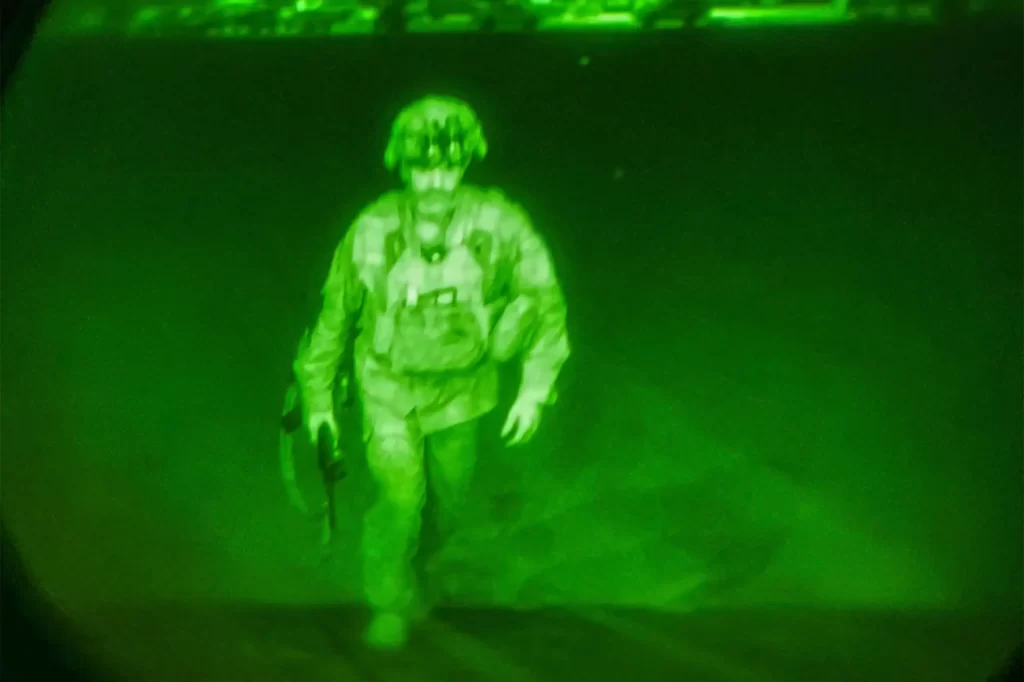
Essentially, the American intervention was never to bring Afghanistan out of a political crisis. Therefore, the growth of political institutions and the future of Afghanistan’s government are not the occupier’s concerns. This apathy paved the way for the resurgence of the Taliban. Whether based on unilateralism or multilateralism, militarism or liberalism, the Bush Doctrine is fundamentally a neoconservative creation. It always manifests American primacy.
Conclusion
In the initial years of the War on Terror, the vindication for the United States to invade Afghanistan was chiefly to defend national security. By and large, those efforts were devoted to the decimation of al-Qaeda, and the dismembering of all similar groups fostered in rouge states. The strategy seemed persuasive against the backdrop of the 9/11 fiasco. Yet, it could not justify Bush’s impertinent military campaign in an already languished state.
Towards the end of the first term of the Bush presidency decision-makers resorted remarkably to the democratization of Afghanistan as a guarantee of American security and national interests, surpassing reasons invoked in the name of pure security. Bush doctrine did not die out in 2008 when a Democrat replaced the Republican President. Despite the criticisms and costs incurred, the Bush doctrine continued to guide United States’ Afghanistan policy afterwards until its withdrawal in August 2021. The legacy of the Bush doctrine will endure in America’s future engagements with its ‘enemies’.
You may also like:
The US’s Strong Involvement in Taiwan and the Escalating Hostilities Between the Superpowers
About the Author

Anaina M Raj is a freelance writer and an avid observer of world politics. She tries to explore the alternative narratives and latent dimensions of interstate and intrastate relations. She holds MA in International Politics from Jawaharlal Nehru University (JNU), New Delhi. Her research interests include international security, geopolitics, IR theory, securitisation and foreign policy.

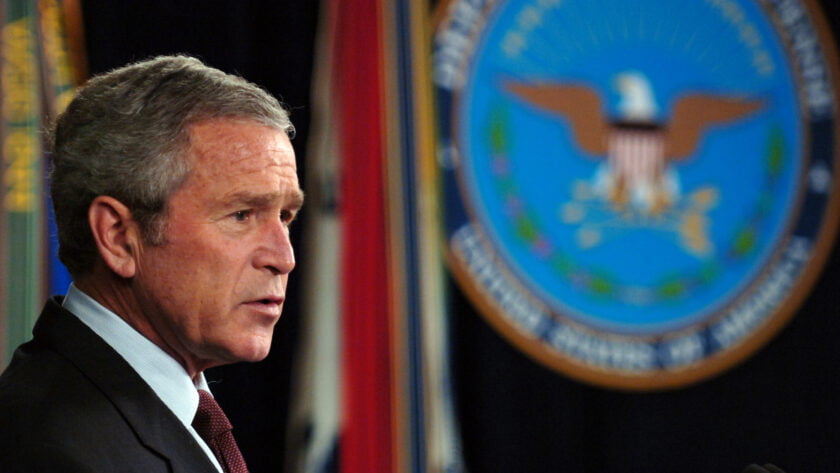





[…] How the Bush Doctrine Contributed to the Failure of the US Military Campaign in Afghanistan? […]